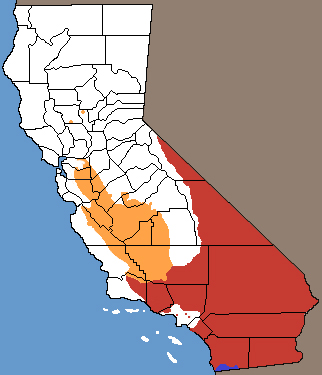
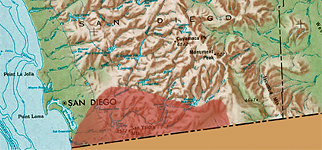 Red
Red: Close-up of Historic Range of
Masticophis fuliginosus in California
|
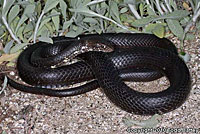 |
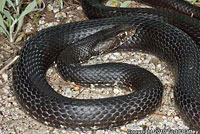 |
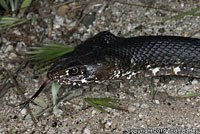 |
| Dark phase adult, San Diego County, © Todd Battey. Specimen courtesy of Bob Applegate. |
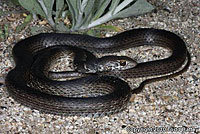 |
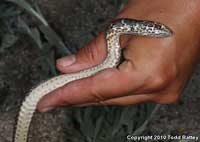 |
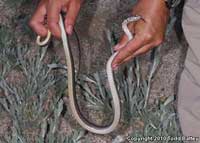 |
| Dark phase sub-adult, San Diego County, © Todd Battey |
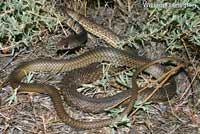 |
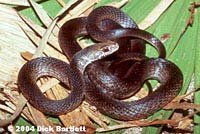 |
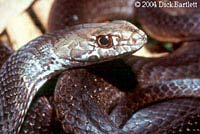 |
| Adult, 3030 ft. elevation, San Diego County © William Flaxington |
Dark phase adult, San Diego County, © 2004 Dick Bartlett |
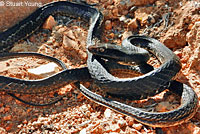 |
 |
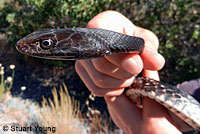 |
| Recently-shed adult with some un-shed skin still remaining, San Diego County © Stuart Young |
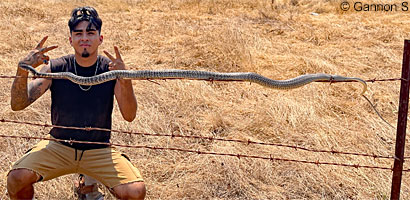 |
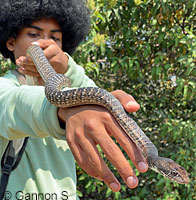 |
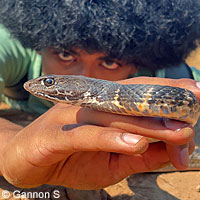 |
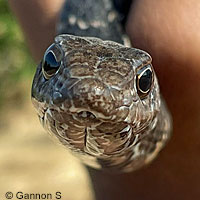 |
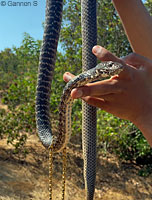 |
| An approximately 4.5 foot-long (137 cm) adult Baja California Coachwhip found in San Diego County. © Gannon S |
| |
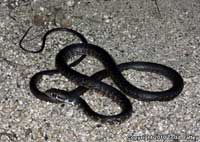 |
|
| |
Dark phase juvenile, San Diego County,
© Todd Battey. Specimen courtesy of Bob Applegate.
|
|
 |
| Adult, San Diego County © Alison Davies |
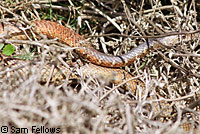 |
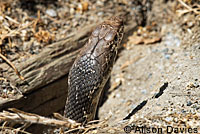 |
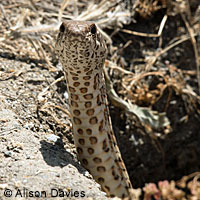 |
Adult, southwestern San Diego County
© Sam Fellows
According to Jeff Lemm (author of Field Guide to the Amphibians and Reptiles of the San Diego Region) this is a Baja California Coachwhip. He told me that snakes from the area where this one was photographed are mottled yellowish or tan instead of the dark phase found in other areas in California. |
Two views of one adult with its head raised out of a hole
in
typical hunting posture, San Diego County © Alison Davies
Notice the narrow front of the head that improves the snake's binocular vision. |
| |
|
|
| Baja California Coachwhips from Baja California |
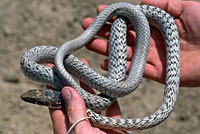 |
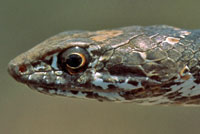 |
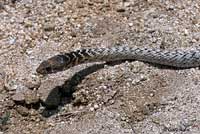 |
| Light phase Adult, Baja California Sur |
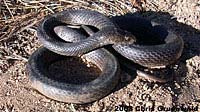 |
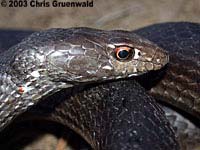 |
|
Dark phase adult, Baja California © Chris Gruenwald
|
|
| |
|
|
| Short Video |
| |
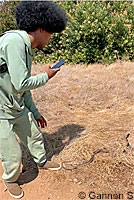 |
|
| |
A large adult coachwhip in San Diego County shows off its speed when it is released where it was found.
© Gannon S |
|
| |
|
|
| Habitat |
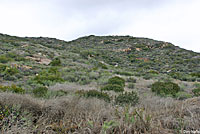 |
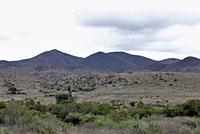 |
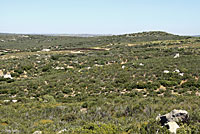 |
Habitat, coastal southwest
San Diego County |
Habitat, coastal southwest
San Diego County |
Habitat, southeast San Diego County
on the border |
| |
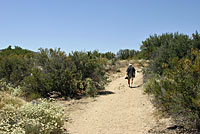 |
|
| |
Habitat, southeast San Diego County |
|
|
|
|
| Description |
Not Dangerous - This snake does not have venom that can cause death or serious illness or injury in most humans.
Commonly described as "harmless" or "not poisonous" to indicate that its bite is not dangerous, but "not venomous" is more accurate. (A poisonous snake can hurt you if you eat it. A venomous snake can hurt you if it bites you.)
|
| Length |
Adults are normally 24-52 inches long (62-132 cm.)
|
| Appearance |
A slender fast-moving snake with smooth scales, a large head and eyes, a thin neck, and a long thin tail.
(There is no well-defined stripe lengthwise on the body in this species.)
Large scales above the eyes.
17 rows of scales at midbody.
The braided appearance of scales on the tail (like a whip) gives this species its common name.
|
| Color and Pattern |
There are two color phases (from Stebbins, 2003)
1) Dark phase:
Dark brown or dark gray to black above. Light edges on dark scales may give the appearance of light lines on the sides, more prominent toward the front of the body.
Sometimes
appears to be all black.
2)
Light phase: Dark or pale yellow, tan, light gray or silvery above with dark zigzag cross-bands on the body and wider dark bands on the neck.
Only the dark phase has been found in California.
The venter is light in color with brown spots.
|
| Life History and Behavior |
Activity |
Active in the daytime.
Good climbers, able to climb bushes and trees. Seen moving quickly even on hot sunny days, but often seen basking on roads in early morning or resting underneath boards or other surface objects.
Frequently run over by vehicles and found dead on the road, partly due to the tendency of this snake to stop and eat road-killed small animals.
Crawls into the hollow stumps of plants such as agave for refruge.
|
| Defense |
| Often strikes aggressively when threatened or handled. |
| Diet and Feeding |
Eats small mammals including bats, nestling and adult birds, bird eggs, lizards, snakes, amphibians, and carrion.
Hatchlings and juveniles will eat large invertebrates.
The ability to tolerate high temperatures enables
this snake to hunt heat-dependent lizards when they are active. High speed allows it to run down the fast-moving
lizards.
Hunts crawling with head the held high above the ground, occasionally moving it from side to side to aid in binocular vision and depth perception.
The prey is overcome and crushed with the jaws or crushed beneath loops of the body then eaten without constriction. |
| Reproduction |
Mating has been observed in northern Baja California in late April.
Females are oviparous, laying eggs.
Eggs have been observed in early August. (Grismer, 2002)
|
| Habitat |
A habitat generalist in Baja California, inhabiting scrub, coastal sand dunes, rocky arroyos, thorn forests, marshlands, and sandy flats.
In California, found mainly in open areas such as grassland, shrubland, and coastal sand dunes.
|
| Geographical Range |
Occurs in California only in a small area of southern San Diego County limited to 6 miles (10km) north of the Baja California border (Lemm, 2006).
Elsewhere, occurs throughout Baja California.
|
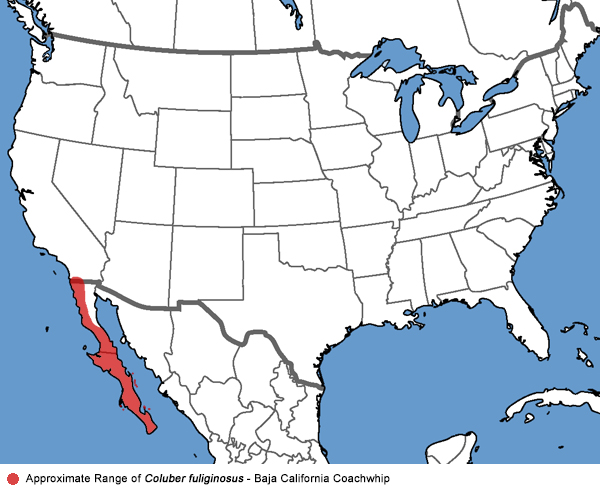 |
| Notes on Taxonomy |
In a study published in 2017, Myers et al found that the genus Masticophis is monophyletic with respect to Coluber. Following this taxonomy Coluber constrictor mormon will remain but the species previously placed in the genus Masticophis on this website have been returned to that genus:
Coluber flagellum - is now Masticophis flagellum
Coluber fuloginosus - is now Masticophis fuliginosus
Coluber lateralis - is now Masticophis lateralis
Coluber taeniatus - is now Masticophis taeniatus
(Edward A. Myers, Jamie L. Burgoon, Julie M. Ray, Juan E. Martinez-Gomez, Noemi Matias-Ferrer, Daniel G. Mulcahy, and Frank T. Burbrink.
Coalescent Species Tree Inference of Coluber and Masticophis. Copeia 105, No. 4, 2017, 642–650)
--------------------------------------------------------------------------------------------------------------------------------------------------------------------
(Some researchers recognize Masticophis fuliginosus - Baja Coachwhip, which also occurs in California, as a subspecies of M. flagellum - M f. fuliginosus.)
--------------------------------------------------------------------------------------------------------------------------------------------------------------------
Former Taxonomy Used Here
North American snakes formerly placed in the genus Masticophis were changed to the genus Coluber based on a 2004 paper * by Nagy et al. Utiger et al. (2005, Russian Journal of Herpetology 12:39-60) supported Nagy et al. and synonymized Masticophis with Coluber. This has not been universally accepted. The most recent SSAR list has hinted that the genus Masticophis might be re-instated: "Burbrink (pers. comm.) has data to reject Nagy et al.’s hypothesis but we await publication of these data before reconsidering the status of Masticophis."
--------------------------------------------------------------------------------------------------------------------------------------------------------------------
Grismer recognized C. fuliginosus as a distinct species in 2002. The snake is still recognized as a subspecies of Coluber flagellum, C. f. fuliginosus, by some authorities.
--------------------------------------------------------------------------------------------------------------------------------------------------------------------
"Myers et al. (2017, Copeia 2017: 642–650), using combined mtDNA and nDNA data, demonstrated that C. constrictor and Masticophis spp. were sister taxa. Therefore, we recognize Masticophis as a genus. The standard English name was changed to reflect this. Myers et al (2024, Zoological Journal of the Linnean Society, zlae018) did not find strong support for some of these subspecies but further research is required to clarify species delineations."
(Nicholson, K. E. (ed.). 2025 SSAR Scientific and Standard English Names List)
--------------------------------------------------------------------------------------------------------------------------------------------------------------------
"O’Connell and Smith (2018, Molecular Phylogenetics and Evolution 127: 356– 366) support recognizing M. fuliginosus as a species."
(Nicholson, K. E. (ed.). 2025 SSAR Scientific and Standard English Names List)
--------------------------------------------------------------------------------------------------------------------------------------------------------------------
Alternate and Previous Names (Synonyms)
Masticophis flagellum fuliginosus - Baja California Coachwhip (Stebbins, 1985, 2003)
Masticophis flagellum piceus - Red Racer (Dark phase = Western Black Racer) (Stebbins, 1966)
Coluber flagellum frenatus - Red Racer (Bascanion flagellum frenatum; Zamensis flagellum flagellum; Zamenis flagellum; Zameis flagelliformis frenatus; Bascanion flagellum frenatum; Bascanium flagelliforme; Bascanium flagelliforme testaceum, part; Bascanium testaceum; Bascanium flagelliforme piceum; Herpetodryas flavigularis; Drymobius testaceus. Western Whip Snake; Yellow Coach-whip Snake, part; Arizona Coach-whip Snake; Coppery Whip Snake) (Grinnell and Camp 1917)
|
| Conservation Issues (Conservation Status) |
Designated a California Species of Special Concern
"...mainly threatened by habitat loss, fragmentation, and road mortality due to development, as well as the inherent demographic threats associated with a very small geographic range."
(Robert C. Thomson, Amber N. Wright, and H. Bradley Shaffer. California Amphibian and Reptile Species of Special ConcernUniversity of California Press, 2016.) |
|
| Taxonomy |
| Family |
Colubridae |
Colubrids |
Oppel, 1811 |
| Genus |
Masticophis |
Coachwhips and Whipsnakes |
Baird & Girard, 1853 |
Species
|
fuliginosus |
Baja California Coachwhip |
(Cope, 1895) |
|
Original Description |
Masticophis flagellum fuliginosus - (Cope, 1895) - Amer. Nat., Vol. 29, p. 679
from Original Description Citations for the Reptiles and Amphibians of North America © Ellin Beltz
|
|
Meaning of the Scientific Name |
Masticophis - Greek - mastix = whip + ophis = referring to the body shape and braided appearance of the tail
fuliginosus - Latin - fuligo = soot or black + -osus = fulness of (probably referring to the dark morph of this species)
from Scientific and Common Names of the Reptiles and Amphibians of North America - Explained © Ellin Beltz
|
|
Alternate Names |
Masticophis flagellum fuliginosus - Baja California Coachwhip
Masticophis fuliginosus - Baja California Coachwhip
|
|
Related or Similar California Snakes |
M. f. piceus - Red Racer
M. f. ruddocki - San Joaquin Coachwhip
S. h. hexalepis - Desert Patch-nosed Snake
S. h. mojavensis - Mojave Patch-nosed Snake
S. h. virgultea - Coast Patch-nosed Snake
|
|
More Information and References |
California Department of Fish and Wildlife
Jeff M. Lemm. Field Guide to the Amphibians and Reptiles of the San Diego Region. University of California Press, 2006.
Hansen, Robert W. and Shedd, Jackson D. California Amphibians and Reptiles. (Princeton Field Guides.) Princeton University Press, 2025.
Stebbins, Robert C., and McGinnis, Samuel M. Field Guide to Amphibians and Reptiles of California: Revised Edition (California Natural History Guides) University of California Press, 2012.
Stebbins, Robert C. California Amphibians and Reptiles. The University of California Press, 1972.
Flaxington, William C. Amphibians and Reptiles of California: Field Observations, Distribution, and Natural History. Fieldnotes Press, Anaheim, California, 2021.
Nicholson, K. E. (ed.). 2025. Scientific and Standard English Names of Amphibians and Reptiles of North America North of Mexico, with Comments Regarding Confidence in Our Understanding. Ninth Edition. Society for the Study of Amphibians and Reptiles. [SSAR] 87pp.
Samuel M. McGinnis and Robert C. Stebbins. Peterson Field Guide to Western Reptiles & Amphibians. 4th Edition. Houghton Mifflin Harcourt Publishing Company, 2018.
Stebbins, Robert C. A Field Guide to Western Reptiles and Amphibians. 3rd Edition. Houghton Mifflin Company, 2003.
Behler, John L., and F. Wayne King. The Audubon Society Field Guide to North American Reptiles and Amphibians. Alfred A. Knopf, 1992.
Robert Powell, Roger Conant, and Joseph T. Collins. Peterson Field Guide to Reptiles and Amphibians of Eastern and Central North America. Fourth Edition. Houghton Mifflin Harcourt, 2016.
Powell, Robert., Joseph T. Collins, and Errol D. Hooper Jr. A Key to Amphibians and Reptiles of the Continental United States and Canada. The University Press of Kansas, 1998.
Bartlett, R. D. & Patricia P. Bartlett. Guide and Reference to the Snakes of Western North America (North of Mexico) and Hawaii. University Press of Florida, 2009.
Bartlett, R. D. & Alan Tennant. Snakes of North America - Western Region. Gulf Publishing Co., 2000.
Brown, Philip R. A Field Guide to Snakes of California. Gulf Publishing Co., 1997.
Ernst, Carl H., Evelyn M. Ernst, & Robert M. Corker. Snakes of the United States and Canada. Smithsonian Institution Press, 2003.
Taylor, Emily. California Snakes and How to Find Them. Heyday, Berkeley, California. 2024.
Wright, Albert Hazen & Anna Allen Wright. Handbook of Snakes of the United States and Canada. Cornell University Press, 1957.
Grismer, L. Lee. Amphibians and Reptiles of Baja California, Including Its Pacific Islands and the Islands in the Sea of Cortés. The University of California Press, 2002.
McPeak, Ron H. Amphibians and Reptiles of Baja California. Sea Challengers, 2000.
Samuel M. McGinnis and Robert C. Stebbins. Peterson Field Guide to Western Reptiles & Amphibians. 4th Edition. Houghton Mifflin Harcourt Publishing Company, 2018.
Stebbins, Robert C. A Field Guide to Western Reptiles and Amphibians. 3rd Edition. Houghton Mifflin Company, 2003.
The Reptile Database
* Z. T. Nagy, Robin Lawson, U. Joger and M. Wink. Molecular systematics of Racers, Whipsnakes and relatives (Reptilia: Colubridae) using Mitochondrial and Nuclear Markers. Journal of Zoological Systematics and Evolutionary Research (Volume 42 pages 223–233). 2004
Robert C. Thomson, Amber N. Wright, and H. Bradley Shaffer. California Amphibian and Reptile Species of Special Concern. University of California Press, 2016.
Joseph Grinnell and Charles Lewis Camp. A Distributional List of the Amphibians and Reptiles of California. University of California Publications in Zoology Vol. 17, No. 10, pp. 127-208. July 11, 1917.
|
|
|
The following conservation status listings for this animal are taken from the July 2025 State of California Special Animals List and the July 2025 Federally Listed Endangered and Threatened Animals of California list (unless indicated otherwise below.) Both lists are produced by multiple agencies every year, and sometimes more than once per year, so the conservation status listing information found below might not be from the most recent lists, but they don't change a great deal from year to year.. To make sure you are seeing the most recent listings, go to this California Department of Fish and Wildlife web page where you can search for and download both lists:
https://www.wildlife.ca.gov/Data/CNDDB/Plants-and-Animals.
A detailed explanation of the meaning of the status listing symbols can be found at the beginning of the two lists. For quick reference, I have included them on my Special Status Information page.
If no status is listed here, the animal is not included on either list. This most likely indicates that there are no serious conservation concerns for the animal. To find out more about an animal's status you can also go to the NatureServe and IUCN websites to check their rankings.
Check the current California Department of Fish and Wildlife sport fishing regulations to find out if this animal can be legally pursued and handled or collected with possession of a current fishing license. You can also look at the summary of the sport fishing regulations as they apply only to reptiles and amphibians that has been made for this website.
The California Special Animals List shows this snake as Masticophis fuliginosus - Baja California coachwhip.
|
| Organization |
Status Listing |
Notes |
| NatureServe Global Ranking |
G5 |
Secure
(This snake is very common in Baja California)
|
| NatureServe State Ranking |
S1S2 |
Critically Imperiled - Imperiled |
| U.S. Endangered Species Act (ESA) |
None |
|
| California Endangered Species Act (CESA) |
None |
|
| California Department of Fish and Wildlife |
SSC |
Species of Special Concern |
| Bureau of Land Management |
None |
|
| USDA Forest Service |
None |
|
| IUCN |
None |
|
|
|




































